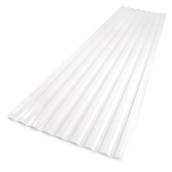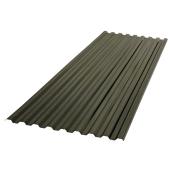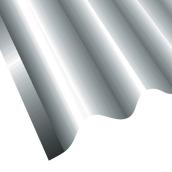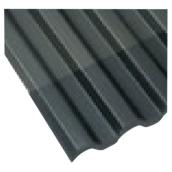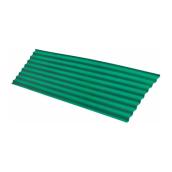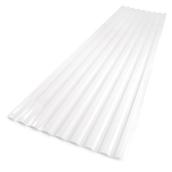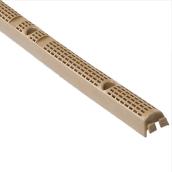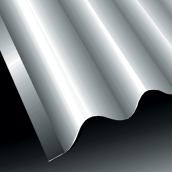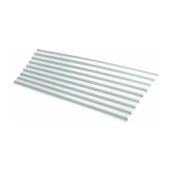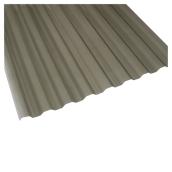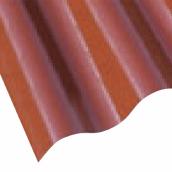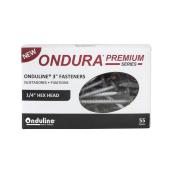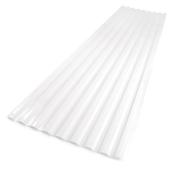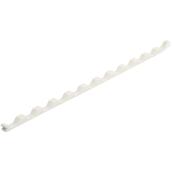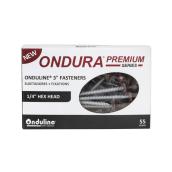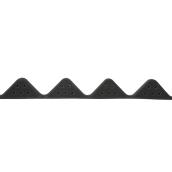Corrugated Panels (25)
Corrugated panels have ribs that make the panels stronger than a flat piece of the same material. They provide exceptional structural stability and are available in roofing and siding options. Some materials used to make corrugated siding panels are PVC, polycarbonate, vinyl, and metal. Metal panels are suitable for house roofs, and polycarbonate panels are ideal for patio, deck, or hobby greenhouse roofs.
Explore Rona’s many siding options before deciding on a solution. Choose from vertical siding, natural wood grain, or stone and veneer siding, and have fun remodelling your home or cottage.
Use corrugated panels to create an instant roof or wall for a structure. They’re suitable for use in a variety of projects, including carports, greenhouses, sheds, and more. You can also use these materials as exterior siding panels on walls.
The benefits of this material include its lightweight design for simple setup, and its curved channel structure that provides points of resistance against stress. Corrugated siding panels are available in pvc or polycarbonate material. The choice of what type of corrugated panel to use depends on your aesthetic preference, and the nature of the project. For instance, a greenhouse needs light for the plants, so clear or translucent vinyl is the best choice.
Corrugated panels are fast and easy to set up. Screw them into place, and that phase of the project is complete. The structure material you are attaching the panels to can determine the fastener to use. Galvanized screws or nails both work for wooden structures, while screws work best with a metal structure. Screws also make repairs much easier. Just unscrew the panel, lift off and remove the damaged segment of the panel, and replace it with a new one. Corrugated siding panels are wide enough to cover a large area, but not so wide to make it inconvenient to replace a single segment.
There are a few considerations to keep in mind whenever working with corrugated siding panels. The curved shape of the pieces requires fasteners that have flexible washers. This creates a better seal against water. Likewise, end pieces that match the curve of the panels can seal off the spot at the edge of the roof or wall to prevent rain from leaking in, and insulate against heat exchange. It also keeps air from getting in under the panels if you have them on the roof, which can prevent them from blowing away in high winds. Consider foam closures to seal panels.
Explore Rona’s many siding options before deciding on a solution. Choose from vertical siding, natural wood grain, or stone and veneer siding, and have fun remodelling your home or cottage.
Use corrugated panels to create an instant roof or wall for a structure. They’re suitable for use in a variety of projects, including carports, greenhouses, sheds, and more. You can also use these materials as exterior siding panels on walls.
The benefits of this material include its lightweight design for simple setup, and its curved channel structure that provides points of resistance against stress. Corrugated siding panels are available in pvc or polycarbonate material. The choice of what type of corrugated panel to use depends on your aesthetic preference, and the nature of the project. For instance, a greenhouse needs light for the plants, so clear or translucent vinyl is the best choice.
Corrugated panels are fast and easy to set up. Screw them into place, and that phase of the project is complete. The structure material you are attaching the panels to can determine the fastener to use. Galvanized screws or nails both work for wooden structures, while screws work best with a metal structure. Screws also make repairs much easier. Just unscrew the panel, lift off and remove the damaged segment of the panel, and replace it with a new one. Corrugated siding panels are wide enough to cover a large area, but not so wide to make it inconvenient to replace a single segment.
There are a few considerations to keep in mind whenever working with corrugated siding panels. The curved shape of the pieces requires fasteners that have flexible washers. This creates a better seal against water. Likewise, end pieces that match the curve of the panels can seal off the spot at the edge of the roof or wall to prevent rain from leaking in, and insulate against heat exchange. It also keeps air from getting in under the panels if you have them on the roof, which can prevent them from blowing away in high winds. Consider foam closures to seal panels.
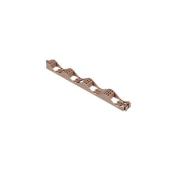
VIC WEST
Vic West Palruf 6-Pack Plastic Horizontal Roof Panel Strip - 24-in - Beige
18
.
59
Pack
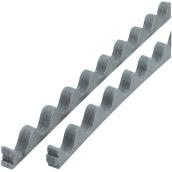
VIC WEST
Vic West Palruf 6-Pack Horizontal Roof Panel Strip - Foam - 36-in - Grey
28
.
99
Pack
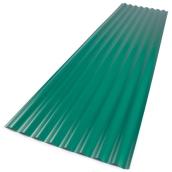
VIC WEST
Vicwest Suntop Roof panel - 26-in x 8-ft - Polycarbonate - Forest Green
37
.
99
Each










